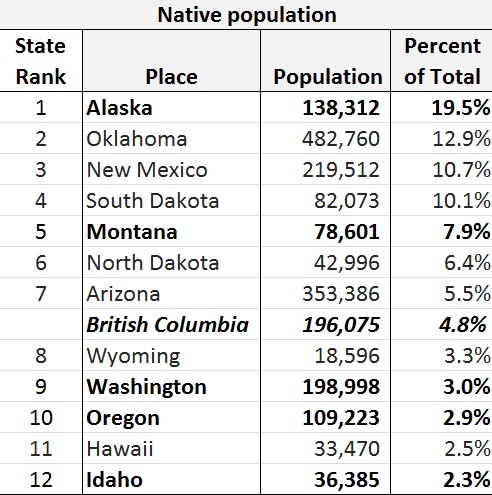November is American Indian & Alaska Native Heritage Month, and that makes a good opportunity to take a quick look at the Northwest’s original residents. In North American terms, Cascadia is home to an unusually high concentration of people of Native descent.
In fact, Northwest jurisdictions are home to more than three quarters of a million people of Native descent with nearly 200,000 in British Columbia and Washington each.
As a share of the population, no state has more Native Americans than Alaska where nearly 20 percent of residents self-identify as all or part Native. Montana ranks 5th nationally while Washington, Oregon, and Idaho occupy the 9th, 10th, and 12th spots, respectively. British Columbia’s population has a very similar profile to its US neighbors.
Let’s look more closely at the US portion of the Northwest, where localized population figures are easily available.
Census statistics show that most of the most populous Native lands in the region are found in Alaska or Washington.
It’s worth noting that to produce this ranking for the Cascadia bioregion, I included some lands in the Anchorage area, but nothing west of there; and I ignored Montana areas east of the Rocky Mountains, which excluded many of the populous reservations located in that state. (TDSA stands for “Tribal Designated Statistical Area”; ANVSA stands for “Alaska Native Village Statistical Area.”)
The Census Bureau’s website has a number of fascinating statistics about American Indians and Alaska Natives. For example, people of Native descent in the US are, on average, much younger than Americans in general, but tend to marry at a slightly older age. American Indians who have bachelor’s degrees are much more likely to hold one in science or engineering than the population at large, but median American Indian incomes are also much lower than American averages, perhaps reflecting their predominately rural locations. (See, I told you it was fascinating.)
Also, here’s an interesting history of American Indian Month.
Notes: Data for US jurisdictions come from US Census Bureau, “Profile of General Population and Housing Characteristics: 2010.” Numbers refer to people who self-identify as American Indian and Alaska Native alone or in combination with one or more other races. Geographic areas refer to American Indian Areas and Alaska Native Areas. Data for BC come from Statistics Canada, “Aboriginal identity population by age groups median age and sex 2006 counts for both sexes for Canada provinces and territories – 20% sample data.” Number refers to the total Aboriginal identity population, which includes the Aboriginal groups (North American Indian Métis and Inuit) multiple Aboriginal responses and Aboriginal responses not included elsewhere.
Thanks to Meaghan Robbins for information that supported this post.











Elaine Livengood
Hmmm, what about the Spokane, Chehalis, Quinault and Makah? They make up a sizable population here in Washington State.
Eric de Place
To be clear, the figures I’m using in second table refer to the population on tribal lands (not to the total number of tribal members).
According to the Census:
Spokane = 2,096
Chehalis = 649
Quinault = 1,408
Makah = 1,414